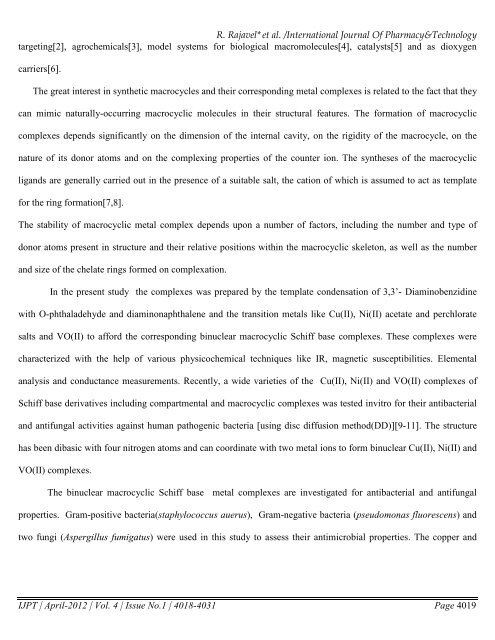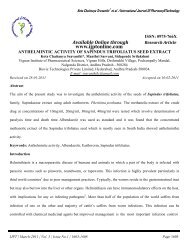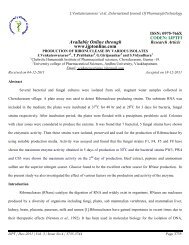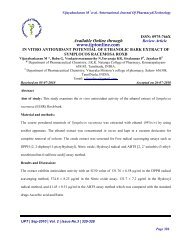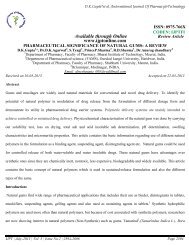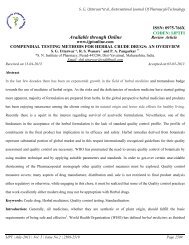Available Online through www.ijptonline.com
Available Online through www.ijptonline.com
Available Online through www.ijptonline.com
You also want an ePaper? Increase the reach of your titles
YUMPU automatically turns print PDFs into web optimized ePapers that Google loves.
R. Rajavel* et al. /International Journal Of Pharmacy&Technology<br />
targeting[2], agrochemicals[3], model systems for biological macromolecules[4], catalysts[5] and as dioxygen<br />
carriers[6].<br />
The great interest in synthetic macrocycles and their corresponding metal <strong>com</strong>plexes is related to the fact that they<br />
can mimic naturally-occurring macrocyclic molecules in their structural features. The formation of macrocyclic<br />
<strong>com</strong>plexes depends significantly on the dimension of the internal cavity, on the rigidity of the macrocycle, on the<br />
nature of its donor atoms and on the <strong>com</strong>plexing properties of the counter ion. The syntheses of the macrocyclic<br />
ligands are generally carried out in the presence of a suitable salt, the cation of which is assumed to act as template<br />
for the ring formation[7,8].<br />
The stability of macrocyclic metal <strong>com</strong>plex depends upon a number of factors, including the number and type of<br />
donor atoms present in structure and their relative positions within the macrocyclic skeleton, as well as the number<br />
and size of the chelate rings formed on <strong>com</strong>plexation.<br />
In the present study the <strong>com</strong>plexes was prepared by the template condensation of 3,3’- Diaminobenzidine<br />
with O-phthaladehyde and diaminonaphthalene and the transition metals like Cu(II), Ni(II) acetate and perchlorate<br />
salts and VO(II) to afford the corresponding binuclear macrocyclic Schiff base <strong>com</strong>plexes. These <strong>com</strong>plexes were<br />
characterized with the help of various physicochemical techniques like IR, magnetic susceptibilities. Elemental<br />
analysis and conductance measurements. Recently, a wide varieties of the Cu(II), Ni(II) and VO(II) <strong>com</strong>plexes of<br />
Schiff base derivatives including <strong>com</strong>partmental and macrocyclic <strong>com</strong>plexes was tested invitro for their antibacterial<br />
and antifungal activities against human pathogenic bacteria [using disc diffusion method(DD)][9-11]. The structure<br />
has been dibasic with four nitrogen atoms and can coordinate with two metal ions to form binuclear Cu(II), Ni(II) and<br />
VO(II) <strong>com</strong>plexes.<br />
The binuclear macrocyclic Schiff base metal <strong>com</strong>plexes are investigated for antibacterial and antifungal<br />
properties. Gram-positive bacteria(staphylococcus auerus), Gram-negative bacteria (pseudomonas fluorescens) and<br />
two fungi (Aspergillus fumigatus) were used in this study to assess their antimicrobial properties. The copper and<br />
IJPT | April-2012 | Vol. 4 | Issue No.1 | 4018-4031 Page 4019


